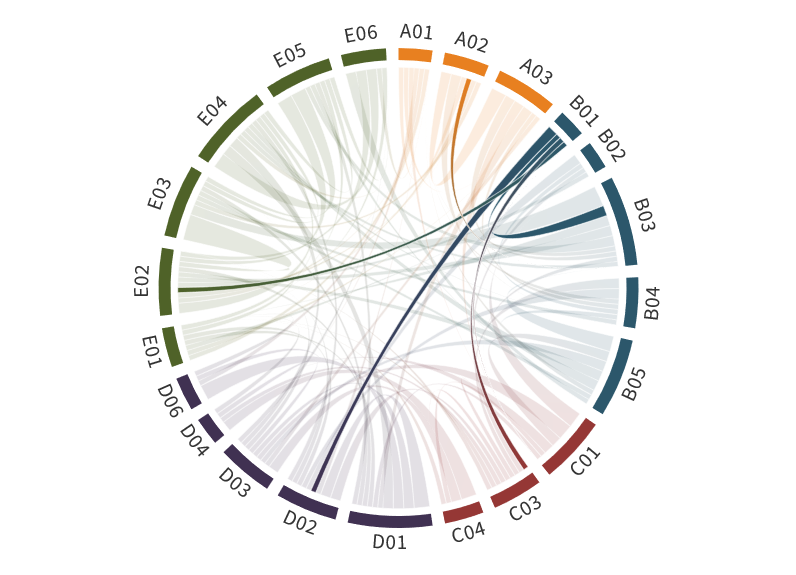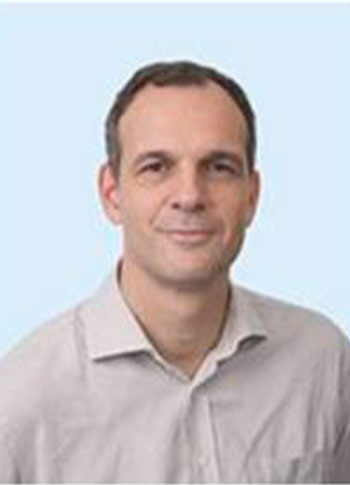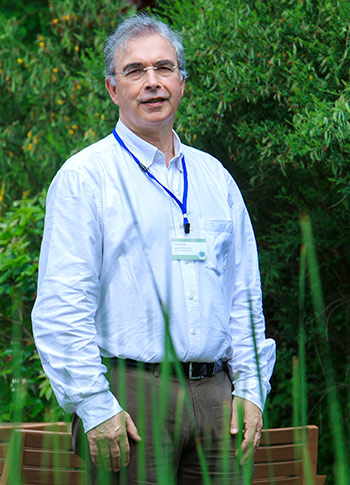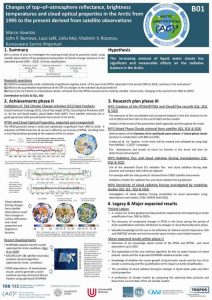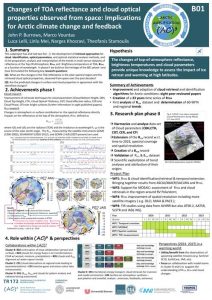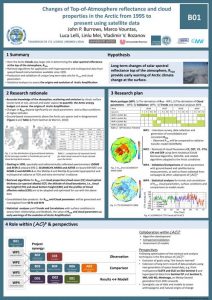B01: Changes of the top–of–atmosphere reflectance, brightness temperatures, and cloud properties in the Arctic from 1995 to the present derived from satellite data
PI: Marco Vountas (former PI: John P. Burrows)
The radiative balance of the Arctic depends on the absorption and scattering of solar radiation (shortwave, SW) and terrestrial radiation (longwave, LW) and their resultant upward and downward SW and LW fluxes. Changes in the temperature, the amounts and distributions of water vapor, and the number and availability of Cloud Condensation Nuclei (CCN) and Ice Nucleating Particles (INP) lead to changes in the optical properties of clouds. This, in turn, leads to changes in the SW scattering and LW absorption and emission of electromagnetic radiation by clouds. A better understanding of the fluxes of SW and LW radiation, the changing properties of clouds, the Earth’s surface, and the resulting SW reflectance and LW absorption and emission at the top and the bottom of the atmosphere is required to explain the processes determining Arctic amplification, and to test and thereby improve the accuracy of models and their projections of the Arctic climate. In phase II of the (AC)³ project B01, we discovered that the pan-Arctic changes in the reflectance at the top-of-atmosphere, RTOA, retrieved from the measurements of satellite instruments, were significantly less than those expected from the changes due to the loss of Sea Ice Extent (SIE) between 1995 and 2018 (Lelli et al., 2023). We explain this behavior by a statistically significant increase in the cloud liquid water phase, and a related decrease in the cloud ice phase. As neither the total mass of condensed water in the clouds, nor the cloud cover change significantly, we infer that observed net changes in the pan-Arctic reflectance RTOA result from decreases in surface reflectance due to the loss of SIE and increases in cloud reflectance. The latter arises because liquid droplets scatter more effectively than ice crystals.
The Cloud Radiative Effect (CRE) is the difference between the net total (SW plus LW) radiative energy flux densities under all-sky and cloud-free conditions (Ramanathan et al., 1989). It plays a central role in quantifying radiative forcing during Arctic amplification. Our investigations of the regionally resolved CRE show that changes in CRE are correlated with changes in the optical thickness of pure liquid clouds (Lelli et al., 2023). Furthermore, our preliminary studies show that it is feasible to retrieve information about mixed-phase clouds using satellite data. In phase III of (AC)³ , building on our research in phases I and II, our objectives are to understand the evolution of Arctic amplification in the period 1995 to 2023 by studying RTOA, Brightness Temperatures at TOA (BTTOA) and the CRE. We plan to extend our database of RTOA and use existing datasets for the BTTOA, e.g., the measurements of AATSR on Envisat (2002-2012) and SLSTR on Sentinel 3 (2016 – present). We shall analyze cloud reflectance changes and the corresponding terrestrial and solar fluxes using existing long-term datasets and then derive CRE estimates.
Hypothesis:
The increasing amount of liquid water clouds has significant and measurable effects on the radiative balance in the Arctic.
To test this hypothesis and improve our understanding, we pose the following questions:
- Will the unexpectedly small, statistically insignificant negative trend of the pan-Arctic RTOA observed in the period 1995 to 2018, continue in the period from 2018 to 2023?
- What is the quantitative dependence of CRE on changes in selected cloud parameters?
- How is the ice volume fraction in mixed-phase clouds, retrieved from the RTOA measurements made by space-borne instruments, changing in the period from 2002 to 2023 in the pan-Arctic?
The scientific objectives of the project B01 contribute to the following Strategic Questions (SQ) of (AC)³: SQ1, which targets the causes of Arctic amplification. In B01 we quantify and analyze the pan-Arctic spatial and temporal changes in RTOA, BTTOA, cloud properties, and CRE and thereby investigate the changes in radiative forcing, which occur during the Arctic amplification. SQ3, which investigates the evolution of Arctic amplification. In B01 selected models used for this purpose in (AC)³ will be evaluated by comparing the pan-Arctic changes in the modeled and measured values of RTOA, cloud properties, and CRE. The results will be used to improve our knowledge of the accuracy of the model projections.
Achievements phase I
B01 investigates changes in the Arctic climate system using the unique long-term satellite data record of top-of-atmosphere reflectance (RTOA) available from hyperspectral and multispectral spectrometers. Based on the compilation of a novel 24 year product merging different sensors a first analysis of the temporal evolution and trends of RTOA was carried out. Significant negative trends were found in some regions and seasons which are consistent with those of decreasing sea ice as expected. However, also positive trends could be identified. For attributing changes to cloud conditions identification algorithms and cloud retrievals were improved for Arctic conditions (Mei et al., 2017a, 2018, 2019).
Role within (AC)³
Key characteristics of the satellite instruments relevent to (AC)³ and their role in the projects can be found here.
Members
Dr. Marco Vountas
Principal Investigator
University of Bremen
Institute of Environmental Physics (IUP)
Otto-Hahn-Allee 1
28359 Bremen
Vinjamuri V S A P M Kameswara Sarma
PhD
University of Bremen
Institute of Environmental Physics (IUP)
Otto-Hahn-Allee 1
28359 Bremen
Former Members
Dr. Narges Khosravi
Postdoc (in phase II)
University of Bremen
Institute of Environmental Physics (IUP)
Otto-Hahn-Allee 1
28359 Bremen
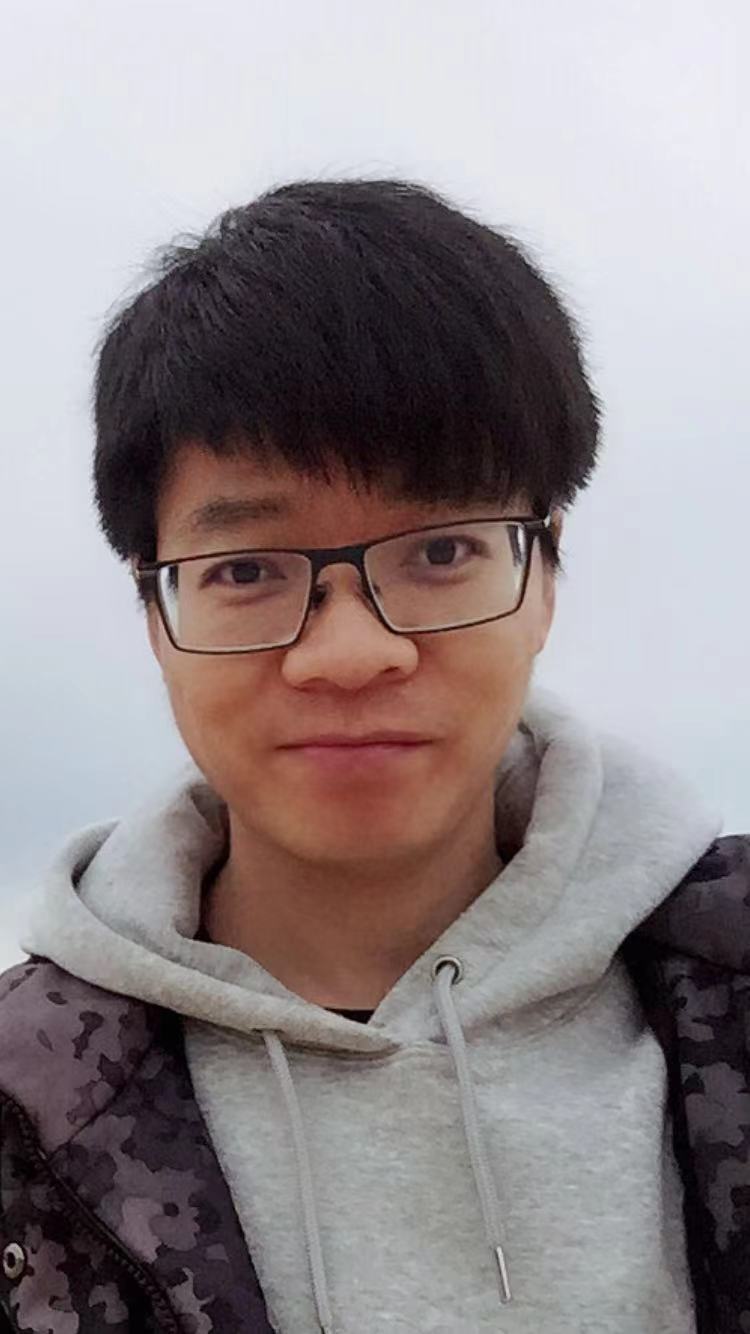
Dr. Linlu Mei
Senior Scientist (in phase I & II)
University of Bremen
Institute of Environmental Physics (IUP)
Otto-Hahn-Allee 1
28359 Bremen
Prof. Dr. John P. Burrows
Principal Investigator
University of Bremen
Institute of Environmental Physics
Otto-Hahn-Allee 1
28334 Bremen
Publications
2024
2023
Mei, L., Rozanov, V., Rozanov, A., and Burrows, J. P.: SCIATRAN software package (V4.6), 2023: update and further development of aerosol, clouds, surface reflectance databases and models, Geosci. Model Dev., 16, 1511–1536, https://doi.org/10.5194/gmd-16-1511-2023.
Vinjamuri, K. S., Vountas, M., Lelli, L., Stengel, M., Shupe, M. D., Ebell, K., and Burrows, J. P., 2023: Validation of the Cloud_CCI (Cloud Climate Change Initiative) cloud products in the Arctic, Atmos. Meas. Tech., 16, 2903–2918, https://doi.org/10.5194/amt-16-2903-2023.
Wendisch, M.; Brückner, M.; Crewell, S.; Ehrlich, A.; Notholt, J.; Lüpkes, C.; Macke, A.; Burrows, J. P.; Rinke, A.; Quaas, J.; Maturilli, M.; Schemann, V.; Shupe, M. D.; Akansu, E. F.; Barrientos-Velasco, C.; Bärfuss, K.; Blechschmidt, A.-M.; Block, K.; Bougoudis, I.; Bozem, H.; Böckmann, C.; Bracher, A.; Bresson, H.; Bretschneider, L.; Buschmann, M.; Chechin, D. G.; Chylik, J.; Dahlke, S.; Deneke, H.; Dethloff, K.; Donth, T.; Dorn, W.; Dupuy, R.; Ebell, K.; Egerer, U.; Engelmann, R.; Eppers, O.; Gerdes, R.; Gierens, R.; Gorodetskaya, I. V.; Gottschalk, M.; Griesche, H.; Gryanik, V. M.; Handorf, D.; Harm-Altstädter, B.; Hartmann, J.; Hartmann, M.; Heinold, B.; Herber, A.; Herrmann, H.; Heygster, G.; Höschel, I.; Hofmann, Z.; Hölemann, J.; Hünerbein, A.; Jafariserajehlou, S.; Jäkel, E.; Jacobi, C.; Janout, M.; Jansen, F.; Jourdan, O.; Jurányi, Z.; Kalesse-Los, H.; Kanzow, T.; Käthner, R.; Kliesch, L. L.; Klingebiel, M.; Knudsen, E. M.; Kovács, T.; Körtke, W.; Krampe, D.; Kretzschmar, J.; Kreyling, D.; Kulla, B.; Kunkel, D.; Lampert, A.; Lauer, M.; Lelli, L.; von Lerber, A.; Linke, O.; Löhnert, U.; Lonardi, M.; Losa, S. N.; Losch, M.; Maahn, M.; Mech, M.; Mei, L.; Mertes, S.; Metzner, E.; Mewes, D.; Michaelis, J.; Mioche, G.; Moser, M.; Nakoudi, K.; Neggers, R.; Neuber, R.; Nomokonova, T.; Oelker, J.; Papakonstantinou-Presvelou, I.; Pätzold, F.; Pefanis, V.; Pohl, C.; van Pinxteren, M.; Radovan, A.; Rhein, M.; Rex, M.; Richter, A.; Risse, N.; Ritter, C.; Rostosky, P.; Rozanov, V. V.; Donoso, E. R.; Saavedra-Garfias, P.; Salzmann, M.; Schacht, J.; Schäfer, M.; Schneider, J.; Schnierstein, N.; Seifert, P.; Seo, S.; Siebert, H.; Soppa, M. A.; Spreen, G.; Stachlewska, I. S.; Stapf, J.; Stratmann, F.; Tegen, I.; Viceto, C.; Voigt, C.; Vountas, M.; Walbröl, A.; Walter, M.; Wehner, B.; Wex, H.; Willmes, S.; Zanatta, M. & Zeppenfeld, S., 2023: Atmospheric and Surface Processes, and Feedback Mechanisms Determining Arctic Amplification: A Review of First Results and Prospects of the (AC)³ Project, Bull. Am. Meteorol. Soc., American Meteorological Society, 104, E208–E242, https://doi.org/10.1175/bams-d-21-0218.1
Mei, L.; Burrows, J.; Zhao, X.; Vountas, M.; Rozanov, V.; Guo, H.; Li, X.; Nakoudi, K. & Ritter, C., 2023: Changes in the Aerosol optical thickness above the ocean in the Arctic observed from space during 1981 and 2020: datasets, trends and origins, Bull. Am. Meteorol. Soc., [submitted to Bull. Am. Meteorol. Soc.]
2022
L. Mei, V. Rozanov, Z. Jiao, J. P. Burrows, 2022, A new snow bidirectional reflectance distribution function model in spectral regions from UV to SWIR: Model development and application to ground-based, aircraft and satellite observations, ISPRS J. Photogramm. Remote Sens., 188, 269-285, https://doi.org/10.1016/j.isprsjprs.2022.04.010
2021
Mei, L., Rozanov, V., Jäkel, E., Cheng, X., Vountas, M., and Burrows, J. P., 2021: The retrieval of snow properties from SLSTR Sentinel-3 – Part 2: Results and validation, Cryosphere, 15, 2781–2802, https://doi.org/10.5194/tc-15-2781-2021.
Mei, L., Rozanov, V., Pohl, C., Vountas, M., and Burrows, J. P., 2021: The retrieval of snow properties from SLSTR Sentinel-3 – Part 1: Method description and sensitivity study, Cryosphere, 15, 2757–2780, https://doi.org/10.5194/tc-15-2757-2021.
2020
Mei, L., Rozanov, V., Burrows, J. P., 2020: A fast and accurate radiative transfer model for aerosol remote sensing, J. Quant. Spectrosc. Radiat. Transfer, 256, 107270, https://doi.org/10.1016/j.jqsrt.2020.107270
L. Mei, V. Rozanov, Ch. Ritter, B. Heinold, Z. Jiao, M. Vountas, J. P.Burrows, 2020, Retrieval of Aerosol Optical Thickness in the Arctic Snow-Covered Regions Using Passive Remote Sensing: Impact of Aerosol Typing and Surface Reflection Model, IEEE Transactions on Geoscience and Remote Sensing, https://doi.org/10.1109/TGRS.2020.2972339
L. Mei, S. Vandenbussche, V. Rozanov, E. Proestakis, V. Amiridis, S. Callewaert, M. Vountas, J. P.Burrows, 2020, On the retrieval of aerosol optical depth over cryosphere using passive remote sensing, Remote Sensing of Enviroment, 241, 111731, https://doi.org/10.1016/j.rse.2020.111731.
2019
Kokhanovsky, A.A., L. Lelli, F. Ducos, and R. Munro, 2019: A Simple Approximation for the Reflectance of a Thick Cloud in Gaseous Absorption Band and Its Application for the Cloud-Top Height Determination, IEEE Transactions on Geoscience and Remote Sensing, doi:10.1109/TGRS.2018.2883358
Mei, L., V.V. Rozanov, H. Jethva, K.G. Meyer, L. Lelli, M. Vountas, and J.P. Burrows, 2019: Extending XBAER algorithm to aerosol and cloud condition, accepted for publication in IEEE Transactions on Geoscience and Remote Sensing, doi:10.1109/TGRS.2019.2919910
Wendisch, M., A. Macke, A. Ehrlich, C. Lüpkes, M. Mech, D. Chechin, K. Dethloff, C. Barrientos, H. Bozem, M. Brückner, H.-C. Clemen, S. Crewell, T. Donth, R. Dupuy, C. Dusny, K. Ebell, U. Egerer, R. Engelmann, C. Engler, O. Eppers, M. Gehrmann, X. Gong, M. Gottschalk, C. Gourbeyre, H. Griesche, J. Hartmann, M. Hartmann, B. Heinold, A. Herber, H. Herrmann, G. Heygster, P. Hoor, S. Jafariserajehlou, E. Jäkel, E. Järvinen, O. Jourdan, U. Kästner, S. Kecorius, E.M. Knudsen, F. Köllner, J. Kretzschmar, L. Lelli, D. Leroy, M. Maturilli, L. Mei, S. Mertes, G. Mioche, R. Neuber, M. Nicolaus, T. Nomokonova, J. Notholt, M. Palm, M. van Pinxteren, J. Quaas, P. Richter, E. Ruiz-Donoso, M. Schäfer, K. Schmieder, M. Schnaiter, J. Schneider, A. Schwarzenböck, P. Seifert, M.D. Shupe, H. Siebert, G. Spreen, J. Stapf, F. Stratmann, T. Vogl, A. Welti, H. Wex, A. Wiedensohler, M. Zanatta, S. Zeppenfeld, 2019: The Arctic Cloud Puzzle: Using ACLOUD/PASCAL Multi-Platform Observations to Unravel the Role of Clouds and Aerosol Particles in Arctic Amplification, Bull. Amer. Meteor. Soc., 100 (5), 841–871, doi:10.1175/BAMS-D-18-0072.1
Andersen, H., J. Cermak, I. Solodovnik, L. Lelli, and R. Vogt, 2019: Spatiotemporal dynamics of fog and low clouds in the Namib unveiled with ground and space-based observations, Atmos. Chem. Phys., 19, 4383-4392, doi:10.5194/acp-19-4383-2019
2018
Khosravi, N., 2018: Space-borne Retrieval of Solar-induceed Plant Fluorescence and its Relationship to photosynthetic Parameters, PhD Thesis, University of Bremen, https://elib.suub.uni-bremen.de/peid=D00106682
Mei, L., V. Rozanov, M. Vountas, J.P. Burrows, 2018: The retrieval of ice cloud parameters from multi-spectral satellite observations of reflectance using a modified XBAER algorithm, Remote Sensing of Environment, 215, 128-144, doi:10.1016/j.rse.2018.06.007
Lelli, L. and Vountas, M., 2018: Chapter 5 – Aerosol and Cloud Bottom Altitude Covariations From Multisensor Spaceborne Measurements, In Remote Sensing of Aerosols, Clouds, and Precipitation, edited by Tanvir Islam, Yongxiang Hu, Alexander Kokhanovsky and Jun Wang, Elsevier, pp 109-127, ISBN 9780128104378, https://doi.org/10.1016/B978-0-12-810437-8.00005-0
Lelli, L., V. V. Rozanov, M. Vountas, J. P. Burrows, 2017: Polarized radiative transfer through terrestrial atmosphere accounting for rotational Raman scattering, J. Quant. Spect. Rad. Trans., 200, 70-89, doi:10.1016/j.jqsrt.2017.05.027
Mei, L., M. Vountas, L. Gómez-Chova, V. Rozanov, M. Jäger, W. Lotz, J. P. Burrows, R. Hollmann, 2017: A Cloud masking algorithm for the XBAER aerosol retrieval using MERIS data, Rem. Sens. Environ., 197, 141-160, doi:10.1016/j.rse.2016.11.016

